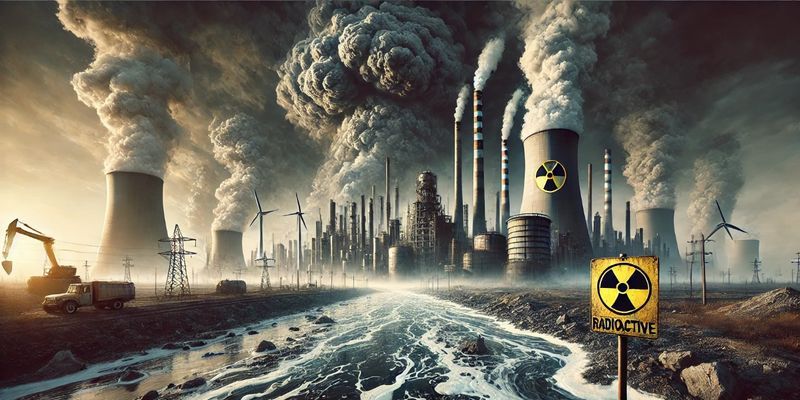The world is full of wonders, but lurking behind the veil of progress are cities that bear the scars of human ambition. From the fallout of nuclear disasters to unchecked industrial emissions, these locations have become cautionary tales of environmental degradation. Let’s dive into the toxic underbelly of human civilisation, exploring how these cities became so polluted, the consequences they face, and some chilling facts about their dystopian realities.
Sumgayit, Azerbaijan: The Chemical Catastrophe

The Cause:
Dubbed the “Chernobyl of the Caspian,” Sumgayit was once the industrial crown jewel of the Soviet Union. By the mid-20th century, it became a hub for over 40 chemical factories producing synthetic rubber, detergents, and industrial pesticides. Unfortunately, Soviet-era negligence and the lack of environmental regulations allowed these factories to spew toxic waste directly into the environment. Untreated wastewater, chemical spills, and air pollutants accumulated for decades, creating an ecological nightmare.
Consequences:
- High cancer rates—up to 51% higher than the national average.
- Rampant birth defects and infant mortality among residents.
- Contaminated soil and groundwater rendered the land almost useless for agriculture.
Uncanny Fact:
Sumgayit’s beaches, once a draw for locals, are now toxic wastelands littered with industrial waste. In 2007, the Blacksmith Institute ranked it among the ten most polluted places on Earth, a grim reminder of its industrial legacy.
Chernobyl, Ukraine: Ground Zero for Radioactive Horror

The Cause:
April 26, 1986, is a date etched in infamy. A flawed safety test at Reactor No. 4 in the Chernobyl Nuclear Power Plant led to the reactor’s explosion, spewing radioactive material across Europe. Poorly trained staff and a reactor design flaw turned a routine test into the worst nuclear disaster in human history.
Consequences:
- Immediate fatalities included 31 plant workers and emergency responders.
- The “Chernobyl Exclusion Zone,” spanning 1,000 square miles, remains largely uninhabitable.
- Over 4,000 thyroid cancer cases linked to radioactive iodine exposure have been recorded.
Uncanny Fact:
Despite the exclusion zone being a ghost town, wildlife has made a surprising comeback. Wolves, bison, and other species thrive in the absence of human activity. Even more bizarre, black frogs in the zone are believed to have evolved darker pigmentation, possibly as protection against radiation.
Dzerzhinsk, Russia: The Land of Chemical Decay

The Cause:
Once a key center for chemical weapons production during the Cold War, Dzerzhinsk manufactured a deadly cocktail of toxins, including sarin gas and mustard agents. The improper disposal of over 300,000 tons of chemical waste into open-air dumps and waterways sealed the city’s toxic fate.
Consequences:
- Water samples show dioxins and phenols at concentrations thousands of times above safety limits.
- Alarmingly low life expectancy: 42 years for men and 47 for women as of 2006.
- Chronic health issues, including respiratory diseases and cancers.
Uncanny Fact:
In 2007, the Guinness Book of World Records crowned Dzerzhinsk the “most chemically polluted city on Earth.” The nearby Black Lake isn’t just a name—it’s a literal toxic soup of industrial chemicals.
Vapi, India: The Mercury Hotspot

The Cause:
Situated in Gujarat’s “Golden Corridor,” Vapi houses over 1,000 small-scale industries producing chemicals, dyes, and pesticides. Industrial growth in the 1980s came without the enforcement of environmental safeguards. Toxic effluents were dumped directly into the Daman Ganga River and surrounding areas.
Consequences:
- The river’s waters are so contaminated that its fish population is almost non-existent.
- Mercury levels in groundwater are 96 times higher than WHO safety standards.
- Local farmers report poor crop yields, and residents suffer from neurological and respiratory illnesses.
Uncanny Fact:
A 2013 report ranked Vapi as one of the most polluted cities in India. What’s scarier? A toxic foam sometimes forms on the Daman Ganga River, eerily reminiscent of a witches’ cauldron bubbling over.
Norilsk, Russia: Siberia’s Smoking Gun

The Cause:
Built atop one of the world’s largest nickel and palladium deposits, Norilsk became a center for metallurgy. The Norilsk Nickel Plant, one of the largest mining and smelting complexes globally, emits more than 1.9 million tons of sulfur dioxide annually, a key culprit in acid rain.
Consequences:
- Respiratory diseases, including chronic bronchitis, are rampant among residents.
- The city’s life expectancy is 10 years below the Russian average.
- A 30-mile “dead zone” surrounds Norilsk, where not a single tree grows, thanks to acid rain.
Uncanny Fact:
Norilsk is often called the “world’s coldest industrial city” and the “largest prison without bars.” Its residents feel trapped by extreme weather conditions, polluted air, and economic dependence on the nickel industry.
The Bigger Picture: A Warning to the World
These toxic cities are more than cautionary tales—they are urgent calls to action. The common threads binding them—unchecked industrialisation, weak environmental regulations, and poor waste management—highlight the need for sustainable practices. As the effects of climate change become more visible in 2024, these polluted landscapes remind us of the costs of prioritising economic growth over environmental stewardship.
Eerie Takeaway: Is Humanity the Real Villain?
These cities stand as haunting monuments to human ambition gone unchecked. If we don’t learn from their tragedies, the next toxic place could be your backyard. After all, as the saying goes: “We do not inherit the Earth from our ancestors; we borrow it from our children.”









![Read more about the article [Funding alert] Computer vision startup Spyne raises $7M in a round led by Accel](https://blog.digitalsevaa.com/wp-content/uploads/2022/04/spyne-1649744827641-300x150.png)
